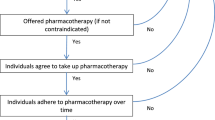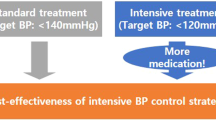Abstract
The Losartan Intervention for Endpoint reduction in hypertension (LIFE) study demonstrated the clinical benefit of losartan-based therapy in hypertensive patients with left ventricular hypertrophy (LVH), mainly due to a highly significant 25% reduction in the relative risk of stroke compared with an atenolol-based regimen, for a similar reduction in blood pressure. The aim of this economic evaluation was to estimate the cost-effectiveness of losartan compared with atenolol from a UK national health system perspective. Quality-adjusted survival and direct medical costs were modelled beyond the trial using the within-trial incidence of stroke. Survival with stroke, study medication use and quality of life by stroke status were taken directly from the LIFE trial. The LIFE data were supplemented with UK data on lifetime direct medical costs of stroke and life expectancy in individuals without stroke. No additional stroke events or use of study treatment were assumed beyond the trial. Costs and benefits were discounted using current UK Treasury rates. In the base-case analysis, the reduction in stroke-related costs (by £968) offset 86% of the increase in study medication costs (£1128) among losartan-treated patients. The incremental cost-effectiveness ratio (ICER) for losartan versus atenolol in hypertensive patients with LVH was £2130 per quality-adjusted life year (QALY) gained (€3195/QALY), and this increased to £11 352 per QALY gained (€16 450/QALY) when the costs of stroke beyond the first 5 years were excluded. Thus, the clinical benefit of losartan was achieved at a cost well within reported thresholds for cost-effectiveness.
This is a preview of subscription content, access via your institution
Access options
Subscribe to this journal
Receive 12 digital issues and online access to articles
$119.00 per year
only $9.92 per issue
Buy this article
- Purchase on Springer Link
- Instant access to full article PDF
Prices may be subject to local taxes which are calculated during checkout




Similar content being viewed by others
References
Murray CJL, Lopez AD . Global mortality, disability, and the contribution of risk factors: Global Burden of Disease Study. Lancet 1997; 349: 1436–1442.
Murray CJL, Lopez AD . Mortality by cause for eight regions of the world: Global Burden of Disease Study. Lancet 1997; 349: 1269–1276.
Wolfe PA, D’Agostino RB, Belanger AJ, Kannel WB . Probability of stroke: a risk profile from the Framingham Study. Stroke 1991; 22: 312–318.
Dahlöf B, Devereux RB, Kjeldsen SE, Julius S, Beevers DG, de Faire U et al. Cardiovascular morbidity and mortality in the Losartan Intervention For Endpoint reduction in hypertension study (LIFE): a randomised trial against atenolol. Lancet 2002; 359: 995–1003.
Coope J, Warrender TS . Randomised trial of treatment of hypertension in elderly patients in primary care. BMJ 1986; 293: 1145–1151.
Medical Research Council Working Party. MRC trial of treatment of mild hypertension: principal results. BMJ 1985; 291: 97–104.
Medical Research Council Working Party. Medical Research Council trial of treatment of hypertension in older adults: principal results. BMJ 1992; 304: 405–412.
Heart disease and stroke statistics – 2005 update. American Heart Association, accessed from http://www.americanheart.org/presenter.jhtml?identifier=3000090.
Beech R, Rudd AG, Tilling K, Wolfe CD . Economic consequences of early inpatient discharge to community-based rehabilitation for stroke in an inner-London teaching hospital. Stroke 1999; 30: 729–735.
Claesson L, Gosman-Hedstrom G, Johannesson M, Fagerberg B, Blomstrand C . Resource utilization and costs of stroke unit care integrated in a care continuum: a 1-year controlled, prospective, randomized study in elderly patients: the Goteborg 70+ Stroke Study. Stroke 2000; 31: 2569–2577.
Reed SD, Blough DK, Meyer K, Jarvik JG . Inpatient costs, length of stay, and mortality for cerebrovascular events in community hospitals. Neurology 2001; 57: 305–314.
Youman P, Wilson K, Harraf F, Kalra L . The economic burden of stroke in the United Kingdom. Pharmacoeconomics 2003; 21 (Suppl 1): 43–50.
Ghatnekar O, Persson U, Glader EL, Terent A . Cost of stroke in Sweden: an incidence estimate. Int J Technol Assess Health Care 2004; 20: 375–380.
Caro JJ, Huybrechts KF . Stroke treatment economic model (STEM): predicting long-term costs from functional status. Stroke 1999; 30: 2574–2579.
Dewey HM, Thrift AG, Mihalopoulos C, Carter R, Macdonell RA, McNeil JJ et al. Lifetime cost of stroke subtypes in Australia. Findings from the North East Melbourne Stroke Incidence Study (NEMESIS). Stroke 2003; 34: 2502–2507.
Terent A, Marke LA, Asplund K, Norrving B, Johsson E, Wester PO . Costs of stroke in Sweden. A national perspective. Stroke 1994; 25: 2363–2369.
Bergman L, van der Meulen JHP, Limburg M, Habbema JDF . Costs of medical care after first-ever stroke in the Netherlands. Stroke 1995; 26: 1830–1836.
Active Ageing. A policy framework. World Health Organization. WHO/NMH/NPH/02.8.
IMS Market Trend Analysis (MTA) for UK Retail and Hospital as assessed by MSD using IMS Health Disease Analyzer-Mediplus data, January 2005.
Caro J, Klittich W, McGuire A, Ford I, Norrie J, Pettitt D et al. The West of Scotland coronary prevention study: economic benefit analysis of primary prevention with pravastatin. BMJ 1997; 315: 1577–1582.
World Health Organization. Life tables and methods: life tables for the United Kingdom 2000. http://www.who.int/countries/gbr/en/.
Carides GW, Heyse JF, Iglewicz B . A regression-based method for estimating mean treatment cost in the presence of right-censoring. Biostatistics 2000; 1: 299–313.
Loader C . Local Regression and Likelihood. Springer-Verlag: New York, 1999.
National Statistics. Consumer price indices – December 2003. 1-20-2004.
Kalbfleish JD, Prentice RL . The Statistical Analysis of Failure Time Data. Wiley: New York, 1980.
Efron BTR . An Introduction to the Bootstrap. Chapman and Hall: New York, 1993.
HM Treasury. The Green Book 2004. http://greenbook.treasury.gov.uk/.
Johnsson B, Carides GW, Burke TA, Dasbach EJ, Lindholm LH, Dahlof B, LIFE Study Group. Cost effectiveness of losartan in patients with hypertension and LVH: an economic evaluation for Sweden of the LIFE trial. J Hypertens 2005; 23: 1425–1431.
Johannesson M, Dahlof B, Lindholm LH, Ekbom T, Hansson L, Oden A et al. The cost-effectiveness of treating hypertension in elderly people – an analysis of the Swedish Trial in Old Patients with Hypertension (STOP Hypertension). J Intern Med 1993; 234: 317–323.
Lamy A, Yusuf S, Pogue J, Gafni A . Cost implications of the use of ramipril in high-risk patients based on the Heart Outcomes Prevention Evaluation (HOPE) study. Circulation 2003; 107: 960–965.
Johannesson M, Johsson B, Kjekshus J, Olsson AG, Pedersen TR, Wedel H . Cost effectiveness of simvastatin treatment to lower cholesterol levels in patients with coronary heart disease. N Engl J Med 1997; 336: 332–336.
Jönsson B, Cook JR, Pedersen TR . The cost-effectiveness of lipid lowering in patients with diabetes: results from the 4S trial. Diabetologia 1999; 42: 1293–1301.
Towse A, Pritchard C . Does NICE have a threshold? An external view. In: Towse A, Pritchard C, Devlin N (eds). Cost-Effectiveness Thresholds. Economic and Ethical Issues. King's Fund and Office of Health Economics: London, 2002.
Eichler H-G, Kong SX, Gerth WC, Mavros P, Jonsson B . Use of cost-effectiveness analysis in health-care resource allocation decision-making: how are cost-effectiveness thresholds expected to emerge? Value Health 2004; 7: 518–528.
Newhouse JP . US and UK health economics: two disciplines separated by a common language? Health Econ 1998; 7 (Suppl): S79–S92.
Kalra L, Evans A, Perez I, Knapp M, Donaldson N, Swift CG . Alternative strategies for stroke care: a prospective randomised controlled trial. Lancet 2000; 356: 894–899.
van Exel J, Koopmanschap MA, van Wijngaarden JDH, Scholte op Reimer WJM . Costs of stroke and stroke services: determinants of patient costs and a comparison of costs of regular care and care organised in stroke services. Cost Eff Resour Alloc 2003; 1: 2.
Taylor TN, Davis PH, Torner JC, Holmes J, Meyer JW, Jacobson MF . Lifetime cost of stroke in the United States. Stroke 1996; 27: 1459–1466.
Wolf-Maier K et al. Hypertension prevalence and blood pressure levels in 6 European countries, Canada, and the United States. JAMA 2003; 289: 2363–2369.
Dahlöf B et al. Population impact of losartan use on stroke in the European Union (EU: projections from the Losartan Intervention For Endpoint reduction in hypertension (LIFE) study. J Hum Hypertens 2004; 18: 367–373.
Olsen P, Burgess E . The rationale for ARBs based on the LIFE Trial: a Canadian thought leader perspective from Ellen D, Burgess, MD, accessed from www.medscape.com/viewarticle/495395.
Acknowledgements
There was no explicit funding for this project.
Author information
Authors and Affiliations
Corresponding author
Rights and permissions
About this article
Cite this article
McInnes, G., Burke, T. & Carides, G. Cost-effectiveness of losartan-based therapy in patients with hypertension and left ventricular hypertrophy: a UK-based economic evaluation of the Losartan Intervention For Endpoint reduction in hypertension (LIFE) study. J Hum Hypertens 20, 51–58 (2006). https://doi.org/10.1038/sj.jhh.1001939
Received:
Accepted:
Published:
Issue Date:
DOI: https://doi.org/10.1038/sj.jhh.1001939
Keywords
This article is cited by
-
Economic evaluation of irbesartan in combination with hydrochlorothiazide in the treatment of hypertension in Greece
The European Journal of Health Economics (2011)
-
Cost-effectiveness of antihypertensive treatment in patients 80 years of age or older in Switzerland: an analysis of the HYVET study from a Swiss perspective
Journal of Human Hypertension (2010)



